Libra constellation lies in the southern sky. It is one of the zodiac constellations, first catalogued by the Greek astronomer Ptolemy in the 2nd century CE. The constellation’s name means “the weighing scales” in Latin. Libra is usually depicted as the scales held by the Greek goddess of justice Dike (or Astraea), represented by the neighbouring Virgo constellation.
Libra is the only zodiac constellation that represents an inanimate object, not an animal or a character from mythology. The four brightest stars in the constellation form a quadrangle. Alpha and Beta Librae mark the scales’ balance beam, and Gamma and Sigma Librae represent the weighing pans. The constellation is represented by the symbol ♎.
Libra does not contain any first magnitude stars. Its brightest stars, Zubeneschamali and Zubenelgenubi, shine at third magnitude. The constellation is home to HD 140283, popularly known as Methuselah Star, one of the oldest stars known. It also hosts HE 1523-0901, a red giant star even older than Methuselah.
Facts, location and map
Libra is the 29th constellation in size, occupying an area of 538 square degrees. It lies in the third quadrant of the southern hemisphere (SQ3) and can be seen at latitudes between +65° and -90°. The neighboring constellations are Centaurus, Hydra, Lupus, Ophiuchus, Scorpius, Serpens Caput and Virgo.
The constellation name Libra is pronounced /ˈli:brə /. In English, the constellation is known as the Scales. The genitive form of Librae, used in star names, is Librae (pronunciation: /ˈlaɪbriː/). The three-letter abbreviation, adopted by the International Astronomical Union (IAU) in 1922, is Lib.
Libra belongs to the zodiac family of constellations, along with Aries, Taurus, Gemini, Cancer, Leo, Virgo, Scorpius, Sagittarius, Capricornus, Aquarius and Pisces.
Libra contains four stars with known planets and does not have any Messier objects. The brightest star in the constellation is Zubeneschamali, Beta Librae, with an apparent magnitude of 2.61. The constellation hosts 83 visible stars (brighter than magnitude 6.50).
There is one meteor shower associated with the constellation, the May Librids.
Libra contains four formally named stars. The star names approved by the International Astronomical Union (IAU) are Brachium (Sigma Librae A), Zubenelgenubi (Alpha2 Librae), Zubenelhakrabi (Gamma Librae A), and Zubeneschamali (Beta Librae).
The best time of the year to see the constellation of Libra is during the month of June, when it appears higher above the horizon around 9 pm.
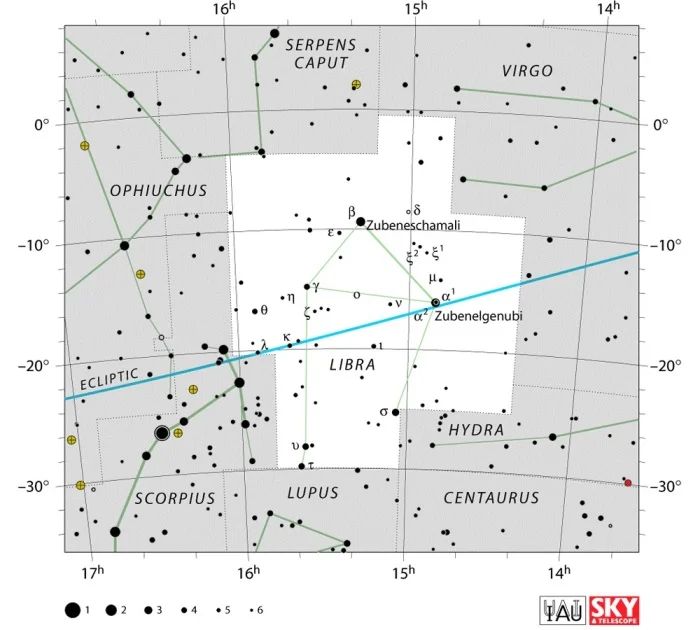
Libra constellation map by IAU and Sky&Telescope magazine
Myth
Ancient Greeks knew the part of the sky occupied by the Libra constellation as Chelae, or “claws,” and considered it part of Scorpio constellation. Chelae represented the Scorpion’s claws.
The association of this region of the sky with scales was established by the Romans in the 1st century BCE. It is said that Moon was located in Libra when Rome was founded. The Romans considered Libra to be a favoured constellation, one associated with balanced seasons and equal length of night and day. The Sun was at the autumnal equinox in Libra until the year 729, when the precession of the equinoxes shifted the equinox to Virgo. The autumnal equinox will move to constellation Leo in the year 2439.
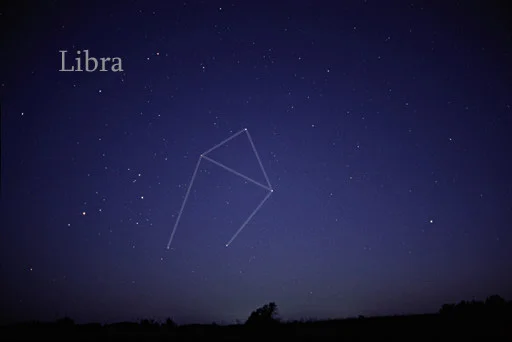
Libra constellation, image: Till Credner (CC BY-SA 3.0)
The Romans were not the first to associate Libra with the idea of balance. The Babylonians called the constellation ZIB.BA.AN.NA, meaning “the balance of heaven,” about a thousand years before Christ.
Once Libra became associated with balance, its association with Scorpio’s claws faded and the one with the goddess of justice, the Greek Dike or Astraeia, represented by the constellation Virgo, became stronger.
As a reminder that Libra was once considered a part of the constellation Scorpius, the brightest star in Libra, Beta Librae, has the name Zubeneschamali, which means “the northern claw” in Arabic, while Alpha Librae, Zubenelgenubi, is “the southern claw.”
Major stars in Libra
Libra is one of the fainter constellations of the zodiac. It does not contain any first or second magnitude stars. Like all zodiac constellations, it is easily visible from the northern hemisphere.
The three brightest stars in Libra – Zubeneschamali, Zubenelgenubi and Brachium – are easy to find because they shine at third magnitude and appear as the extended claws of the brighter Scorpius.
Together with the fainter Zubenelhakrabi, they form the main constellation figure of the celestial Scales. Zubeneschamali and Zubenelgenubi form the balance beam and Brachium and Zubenelhakrabi mark the weighing pans. Upsilon and Tau Librae are sometimes included as part of one of the weighing pans.
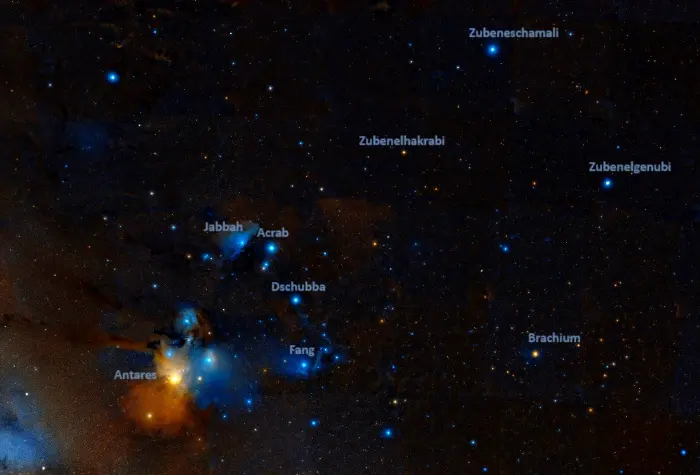
The brightest stars of Libra, appearing right of the Scorpion’s claws, image: Wikisky
Zubeneschamali – β Librae (Beta Librae)
Zubeneschamali (β Lib) is the brightest star in Libra. It has an apparent magnitude of 2.61 and is approximately 185 light years distant from the solar system.
The star’s proper name, Zubeneschamali, comes from the Arabic phrase al-zuban al-šamāliyya, which means “the northern claw.” The name dates back to the time when the stars of Libra were seen as part of Scorpius and represented the Scorpion’s claws. The star’s Latin name is Lanx Borealis, or “the northern scale.”
Zubeneschamali has the stellar classification B8 V, indicating a hot blue-white main sequence star. It has a mass of 3.5 solar masses and a radius 4.9 times that of the Sun. The star is a very fast spinner, with a projected rotational velocity of 250 km/s. It shines with a luminosity of 130 Suns and has an estimated age of only 80 million years.
Beta Librae is catalogued as a single star, but it shows small periodic variations in luminosity (0.03 of a magnitude), which may indicate the presence of a companion.
Zubenelgenubi – α Librae (Alpha Librae)
Zubenelgenubi (α Lib) is the second brightest star in Libra. It lies approximately 75 light-years away.
The name Zubenelgenubi is derived from the Arabic phrase al-zuban al-janūbiyy, which means “the southern claw.” The system is also sometimes known as Kiffa Australis or Elkhiffa Australis. Both names are partial Latin translations and come from the Arabic phrase al-kiffah al-janūbiyy, which means “the southern pan (of the scales).” An older Latin name for the star is Lanx Australis, or “the southern scale.”
Alpha Librae is in fact a multiple system composed of an F-type main sequence star (α1 Lib) and an A-type star (α2 Lib) that is coming to the end of its main sequence lifetime.
The brighter Alpha2 Librae has an apparent magnitude of 2.741 and Alpha1 Librae shines at magnitude 5.153. The two components are separated by 231 arcseconds in the sky, corresponding to a physical distance of about 5,400 astronomical units (AU).
Both visual components – Alpha1 and Alpha2 Librae – are themselves spectroscopic binary stars. The components of Alpha1 orbit each other with a period of 5,870 days at an angular separation of 0.383 arcseconds (10 AU). The components of Alpha2 Librae have masses of 1.95 and 1.79 solar masses.
The Alpha Librae system may have another component. The star KU Librae lies at a separation of 2.6 degrees, corresponding to a physical distance of about 1 parsec. Even though it has a similar proper motion and may be just close enough to be gravitationally bound to the other stars, KU Librae has a different abundance of metals and may not be related to the system.
The Alpha Librae system lies close to the ecliptic and can be occulted by the Moon and, much less frequently, by planets. It will next be occulted by a planet (Mercury) on November 10, 2052.
Brachium – σ Librae (Sigma Librae)
Brachium (σ Lib) is a red giant of the spectral type M2.5III. It has an apparent magnitude of 3.29 and lies approximately 288 light-years away. It has 2.2 times the Sun’s mass and a radius 108 times that of the Sun. The evolved giant star has an effective temperature of 3,596 K and shines with 1,820 solar luminosities.
The star’s traditional name, Brachium, is Latin for “arm.” Sigma Librae was historically also known as Cornu (Latin for “horn”). It once shared the names Zubenalgenubi or Zuben el Genubi (Arabic for “the southern claw”) with Alpha Librae and Zuban Alakrab (“the claws of the Scorpion”) with Gamma Librae.
Brachium only got the Bayer designation Sigma Librae in the 19th century. It was previously known as Gamma Scorpii, even though it appears quite far from the border with the Scorpius constellation. The designation was confirmed by the International Astronomical Union (IAU) on July 31, 1930.
Brachium is classified as a semi-regular variable star with a single pulsation period of 20 days. It exhibits small variations in magnitude of 0.10 to 0.15 over short periods of 15 to 20 minutes every 2.5 to 3 hours. The star’s brightness varies between magnitude 3.20 and 3.46.
Brachium has a 16th magnitude companion at a separation of over an arcminute.
Methuselah – HD 140283
HD 140283 is one of the oldest stars known, believed to have been created shortly after the Big Bang. Nicknamed the Methuselah Star, it is a subgiant star that is very metal poor and consists almost entirely of hydrogen and helium. The star’s iron content is less than 1 percent that of the Sun.
Based on the data obtained with the Hubble Space Telescope, the star’s age was estimated to be 14.46 billion years in 2013. This would make it older than the universe itself. However, the value is uncertain, with a margin of error of 0.8 billion years.
More recent studies have derived an age of 13.7 billion years or 12 billion years.
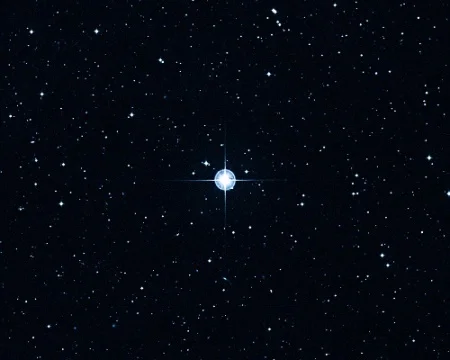
The aging star, cataloged as HD 140283, lies 190.1 light-years away. Hubble Space Telescope was used to narrow the measurement uncertainty on the star’s distance, and this helped refine the calculation of a more precise age of 14.5 billion years (plus or minus 800 million years). The star is rapidly passing through our local stellar neighborhood. The star’s orbit carries it through the plane of our galaxy from the galactic halo that has a population of ancient stars. The Anglo-Australian Observatory (AAO) UK Schmidt telescope photographed the star in blue light. Credit: Digitized Sky Survey (DSS), STScI, AURA, Palomar, Caltech, and UKSTU, AAO
HD 140283 has an apparent magnitude of 7.205 and lies 202.4 light years away. It has a mass of 0.81 solar masses and a radius 2.04 times that of the Sun. With a surface temperature of 5,787 K, it is 4.82 times more luminous than the Sun.
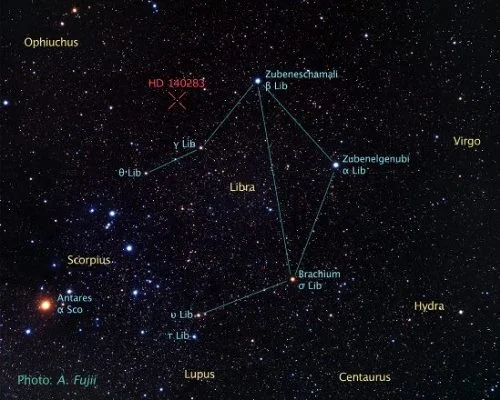
Libra stars and the location of HD 140283. Image: NASA, ESA, H. Bond (STScI and Pennsylvania State University), E. Nelan (STScI), D. VandenBerg (University of Victoria), G. Schaefer (CHARA, Mt. Wilson Observatory), and D. Harmer (NOAO)
HE 1523-0901
HE 1523-0901 is a very old red giant located approximately 9,900 light-years away. It has an apparent magnitude of 11.129.
Like its Libra neighbour Methuselah, HE 1523-0901 is among the oldest stars discovered to date. It has an estimated age of 13.2 billion years, close to the age of the universe itself. The star is believed to have formed from the remnants of the earliest stars that went out as supernovae when the universe was still very young.
HE 1523-0901 has a mass of 0.80 solar masses and a radius of 27 solar radii. With an effective temperature of 4,742 K, it shines with 730 solar luminosities. In 2015, it was discovered to have a spectroscopic companion with a mass of at least 11 Jupiter masses.
υ Librae (Upsilon Librae)
Upsilon Librae is a binary star located around 224 light years away. It has an apparent magnitude of 3.628.
The primary component is an orange giant of the spectral type K3III. It has a mass of 1.67 solar masses and a radius 31.5 times that of the Sun. With a surface temperature of 4,135 K, it is 309 times more luminous than the Sun. The star has an estimated age of 3.14 billion years.
The companion is much fainter, shining at magnitude 10.8. It is separated by 2 arcseconds from the primary star.
In about 3.2 million years, Upsilon Librae will reach a peak brightness of -0.46 and be the brightest star in the Earth’s sky.
τ Librae (Tau Librae)
Tau Librae is a double star with an apparent magnitude of 3.68. It lies 367 light-years away. The star system is a spectroscopic binary star with an orbital period of only 3.3 days.
The primary component is a hot blue main sequence star of the spectral type B2.5 V. It has 7.25 times the Sun’s mass and a radius 3.2 times that of the Sun. It has a surface temperature of 17,990 K and a bolometric luminosity of 2,705 Suns. The star’s estimated age is 31.5 million years.
Tau Librae is a heartbeat star system, a pulsating variable binary star with a highly eccentric orbit. Heartbeat stars can come as close to each other as a few stellar radii and be as far apart as 100 times that distance as they orbit. At their closest approach, the tidal forces cause vibrations and rapid fluctuations in the stars’ shapes, which makes the brightness of these systems variable.
Zubenelhakrabi – γ Librae (Gamma Librae)
Zubenelhakrabi (γ Lib) is a suspected binary star located 163 light-years away. It has an apparent magnitude of 3.91.
The primary component is a yellow giant star of the spectral type G8.5 III. It has a mass of 1.15 solar masses and a radius 11.14 times that of the Sun. With a surface temperature of 4,826 K, it shines with 72 solar luminosities. The star has an estimated age of 4.31 billion years.
The star’s traditional name, Zubenelhakrabi (sometimes spelled as Zubenelakrab or Zuben-el-Akrab), is derived from the Arabic phrase al-Zuban al-Aqrab, which means “the claws of the scorpion.”
Gamma Librae hosts two exoplanets, Gamma Librae b and Gamma Librae c. The discovery of the two gas giants was announced on April 11, 2018.
θ Librae (Theta Librae)
Theta Librae is a yellow giant star of the spectral type G9IIIb. It shines at magnitude 4.136 from a distance of 168 light-years. It appears near the border with the constellation Scorpius.
The evolved star has a mass of 1.47 solar masses and a radius of 12.27 solar radii. With an effective temperature of 4,739 K, it is 68.1 times more luminous than the Sun. It has an estimated age of 3.4 billion years.
ι Librae (Iota Librae)
Iota Librae is a Bayer designation shared by two star systems, Iota1 and Iota2 Librae, that lie at different distances and are not physically related.
Iota1 Librae is a quadruple star system that shines at magnitude 4.54 from a distance of 379 light-years. The inner pair in the system forms a spectroscopic binary system. The primary component, Iota1 Librae Aa, is a silicon-rich B-type subgiant classified as an Alpha2 Canum Venaticorum variable. It forms a spectroscopic binary system with a close companion. The two stars have an orbital period of 22.35 years.
The third component, Iota1 Librae B, is separated by 57 arcseconds from the main pair. It is a tenth magnitude star with a companion at a separation of 1.9 seconds of arc.
Iota2 Librae is a main sequence star of the spectral type A2V. It has an apparent magnitude of 6.1 and lies approximately 290 light-years away. It is 84% more massive than the Sun and a radius 2.314 times that of the Sun. With a surface temperature of 8,526 K, it shines with 20.33 solar luminosities. The star has an estimated age of only 363 million years.
δ Librae (Delta Librae)
Delta Librae is a hot blue main sequence star of the spectral type B9.5V. It lies about 350 light-years away and has an apparent magnitude of 4.93.
Delta Librae has a companion, and the two stars form an eclipsing binary system (an Algol-type variable). The star system’s brightness varies with a period of 2.3274 days, corresponding to the orbital period. The brightness drops to magnitude 5.9 when the fainter component passes in front of the brighter one.
The primary component, Delta Librae A, has a mass 4.9 times that of the Sun and a radius 3.94 times that of the Sun. It is 86 times more luminous than our star, with an effective temperature of 8,800 K. It has an estimated age of 500 million years.
The secondary component, Delta Librae B, is more evolved and less massive. It has a mass 1.7 times that of the Sun.
The star’s traditional name, Zuben Elakribi, or Zuben-el-Akribi, has not been formally approved by the International Astronomical Union (IAU). It comes from the Arabic az-zubānā al-ʿaqrab, which means “the claws of the scorpion.” It has the same origin as Zubenelhakrabi, the formal name of Gamma Librae.
48 Librae
48 Librae is a massive main sequence star of the spectral type B3 Vsh. It has an apparent magnitude of 4.95 and lies 470 light-years away.
The star is an exceptionally fast spinner. With a projected rotational velocity of 400 km/s, it spins at 80% or more of the critical velocity. As a result, it has an oblate shape. The star is flattened at the poles and has an equatorial bulge. Its equatorial radius is believed to be 43% larger than its polar radius.
48 Librae is a shell star. It is surrounded by a gaseous disk that stretches out to 15 times the star’s radius. Shell features that appear in the disk cause the star’s brightness to vary from magnitude 4.74 to 4.96. The star is classified as a Gamma Cassiopeiae variable and has the variable star designation FX Librae.
48 Librae has a mass 6.07 times that of the Sun and a radius of 4.12 solar radii. With a surface temperature of 7,612 K, it is 1,100 times more luminous than the Sun.
Gliese 581 (HO Librae)
Gliese 581 (HO Librae) is a red dwarf star of the spectral type M3V. It has an apparent magnitude that varies between 10.56 and 10.58, and is 20.549 light years distant from the Sun. It is the 89th closest star to the Sun. It appears about two degrees north of the constellation’s brightest star, Beta Librae (Zubeneschamali).
Gliese 581 has about a third of the Sun’s mass (0.295 M☉) and radius (0.302 R☉) and 0.2 percent of its visual luminosity. It is much older than the Sun, with an estimated age of 9.5 billion years.
Gliese 581 is classified as a variable star of the BY Draconis type and is known by the variable designation, HO Librae. BY Draconis variables are typically K or M class main sequence stars that exhibit variations in brightness due to star spots combined with the effects of rotation.
The red dwarf hosts three confirmed planets, designated Gliese 581 b, c, and e. None of them are believed to be habitable.
The innermost planet, Gliese 581 e, was discovered in 2009. It has 2.48 times the Earth’s mass and orbits the parent star at a distance of only 0.02799 astronomical units, taking 3.1481 days to complete an orbit. At the time of discovery, it was the least massive planet known orbiting a normal star. Astronomers initially gave a minimum mass of 1.9 Earth masses, but a 2024 study found that the planet’s true mass was about 30% greater.
Gliese 581 b is the most massive of the three planets. The hot Neptune has a mass of 20.5 Earth masses. It is the second planet in order from the star, with a mean orbital distance of 0.0399 AU. It completes an orbit around the star every 5.3686 days. The planet was discovered in 2005.
Gliese 581 c was discovered in 2007. Classified as a super-Earth, it has a mass of 6.81 Earth masses and an orbital period of 12.9211 days with a semimajor axis of 0.0718 AU. It orbits on the warm edge of the star’s habitable zone and is believed to be too hot to be habitable, not unlike Venus. The planet is tidally locked to Gliese 581, always facing it from the same side.
Several other candidate planets were detected around Gliese 581 – Gliese 581 g, d and f – but their existence was ultimately refuted.
In November 2012, the European Space Agency found a comet belt in the system, one with at least ten times as many comets as the solar system.
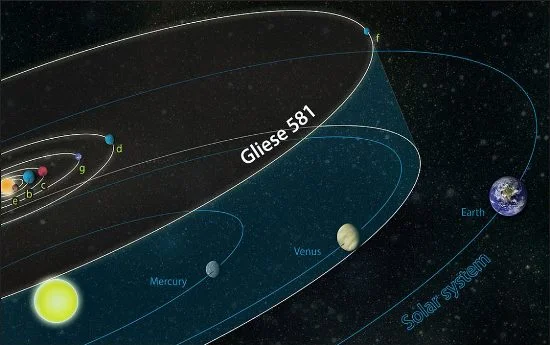
The orbits of planets in the Gliese 581 system are compared to those of our own solar system. The Gliese 581 star has about 30 percent the mass of our Sun, and the outermost planet is closer to its star than the Earth is to the Sun. The 4th planet, G, is a planet that could sustain life. Note: Planet sizes not to scale. Image: Zina Deretsky, National Science Foundation
23 Librae
23 Librae is a Sun-like star, a yellow dwarf with the stellar classification G5 V. It has an apparent magnitude of 6.45 and is on the border of unaided eye visibility. The star lies around 85.39 light-years from the solar system.
23 Librae has a mass of 1.07 solar masses and a radius of 1.25 solar radii. It is much older than the Sun, with an estimated age between 8.4 and 11.1 billion years.
The star hosts two confirmed orbiting planets. Discovered in November 1999, 23 Librae b is a Jovian planet that orbits in the star’s habitable zone. It has a mass of least 1.59 Jupiter masses and orbits the parent star at an average distance of 0.82 AU. It takes 258.19 days to complete an orbit.
23 Librae c has an orbital period of 12.5 – 15 years and a semimajor axis of 5.8 astronomical units. It has a mass of at least 0.82 Jupiter masses. The planet’s discovery was announced on December 14, 2009.
HD 141937
HD 141937 is a yellow dwarf of the spectral type G1V. It has an apparent magnitude of 7.25 and lies 108.9 light-years away. The star is similar to the Sun, with a mass of 1.03 solar masses and a radius of 1.05 solar radii. With a surface temperature of 5,890 K, it shines with 1.202 solar luminosities.
HD 141937 is younger than the Sun, with an estimated age of 3.82 billion years.
The star hosts a substellar companion, a brown dwarf, with a mass of 27.4 Jupiter masses. Discovered in 2001, the companion orbits HD 141937 at a distance of 1.4877 astronomical units, taking 653.22 days to complete an orbit.
Gliese 570 (33 G. Librae)
Gliese 570 (33 G. Librae) is a quadruple star system composed of an orange dwarf, two red dwarfs, and a brown dwarf. The system lies approximately 19 light-years away. It appears southwest of Alpha Librae and northwest of Sigma Librae.
The primary component, Gliese 570 A, is an orange main sequence star of the spectral type K4V. It has a mass of around 0.802 solar masses and a radius of 0.739 solar radii. With a visual luminosity only 16% that of the Sun, it shines at magnitude 5.75 from a distance of 19.199 light-years.
Gliese 570 B and Gliese 570 C are a pair of red dwarfs of the spectral types M1V and M3V. They form a binary system that is separated by 190 astronomical units from the component A. Both stars emit X-rays. They have masses of 0.55 and 0.35 solar masses.
Gliese 570 D is a brown dwarf with the stellar classification T7V. Discovered in 2000, it was one of the coolest brown dwarfs known at the time. It is separated from the other three components by over 1,500 astronomical units and has a mass about 50 times that of Jupiter.
In 1998, an extrasolar planet was reported to orbit the primary component, but its existence was discounted in 2000.
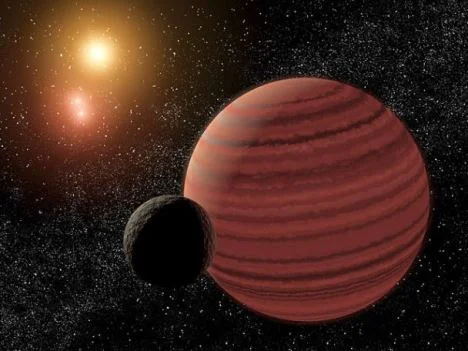
Artist’s impression of Gliese 570 star system, image: Dr. Robert Hurt of the Infrared Processing and Analysis Center. NASA/JPL/CalTech/IPAC
Deep sky objects in Libra
The constellation Libra does not have many bright deep sky objects that can be easily observed in binoculars and small telescopes. It does not host any star clusters, galaxies or nebulae listed in the Messier and Caldwell catalogues. However, it is home to an object listed in the Herschel 400 catalogue, the globular cluster NGC 5897.
NGC 5897
NGC 5897 is a relatively large globular cluster located 40,800 light-years away from the solar system and 24,100 light-years from the Galactic Centre. With an apparent magnitude of 8.52 and an apparent size of 12.6 arcminutes, it can be observed in amateur telescopes.
The cluster was discovered by the German-born British astronomer William Herschel on March 10, 1785.
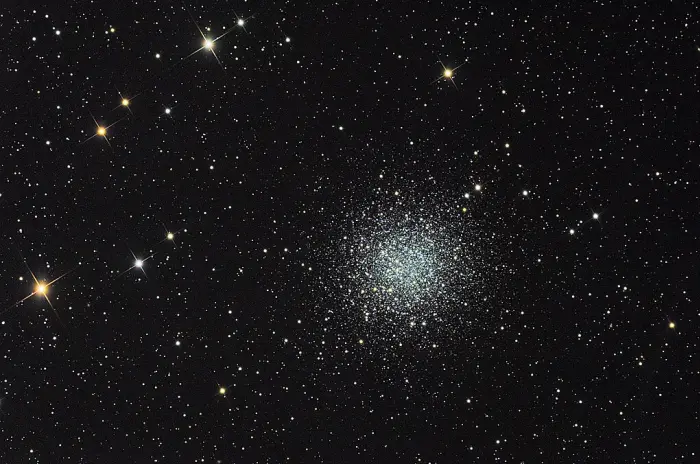
NGC 5897, image credit: San Esteban (CC BY-SA 3.0)
NGC 5885
NGC 5885 is a barred spiral galaxy that appears near Zubeneschamali in the sky. It has an apparent magnitude of 11.8 and an apparent size of 3.5 by 3.1 arcminutes. The galaxy lies 105 million light-years away. It was discovered by William Herschel on May 9, 1784.
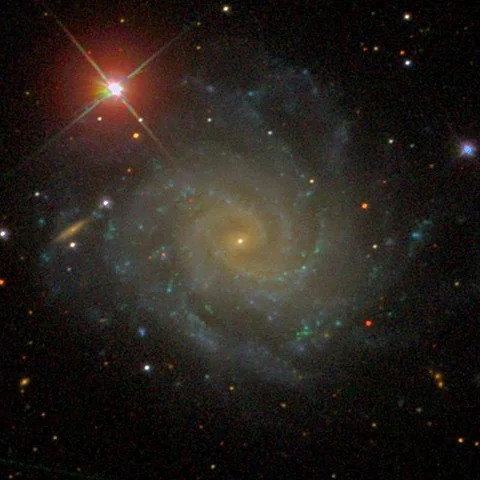
NGC 5885, image: Sloan Digital Sky Survey (CC BY 4.0)
NGC 5792
NGC 5792 is a barred spiral galaxy located approximately 70.27 million light-years away. It has an apparent magnitude of 12.1 and an apparent size of 6.9 by 1.7 arcminutes. It was discovered by William Herschel on April 11, 1787.
The galaxy is a member of the Virgo III Cloud (the Virgo III Groups), a series of galaxy clusters and galaxies stretching east of the Virgo Supercluster.
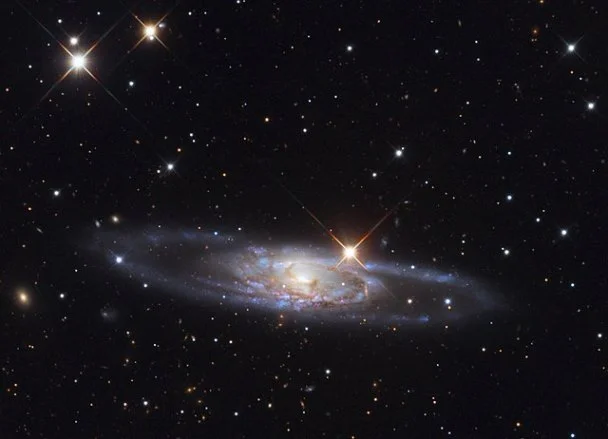
NGC 5792, image: Adam Block/Mount Lemmon SkyCenter/University of Arizona (CC BY-SA 3.0 US)
NGC 5793
NGC 5793 is a type II Seyfert active spiral galaxy located 150 million light-years away. It appears almost edge-on. It has an apparent magnitude of 13.32 and an apparent size of 1.160 by 0.394 arcminutes.
The galaxy was discovered by the American astronomer Francis Leavenworth in 1886.
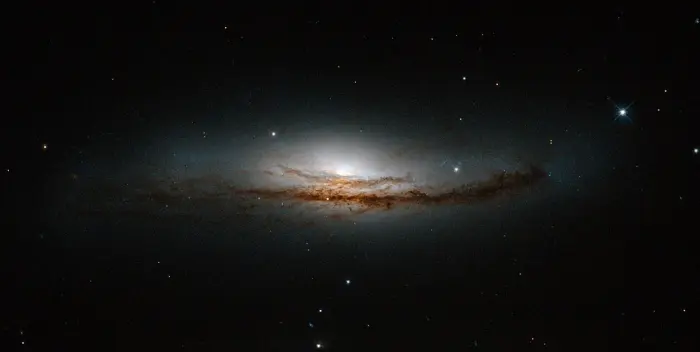
NGC 5793, image credit: NASA, ESA, and E. Perlman (Florida Institute of Technology); Acknowledgement: Judy Schmidt (CC BY 4.0)
NGC 5728
NGC 5728 is a barred spiral galaxy with an apparent magnitude of 13.40, located 145.8 million light-years away. The galaxy is about 97,400 light-years across and has an apparent size of 203.3 arcseconds. It was discovered by William Herschel on May 7, 1787.
NGC 5728 has an active galactic nucleus and a supermassive black hole at its centre. It is classified as a type 2 Seyfert galaxy.
A supernova was discovered in the galaxy in February 2009. Designated SN 2009Y, it shone at magnitude 16 at discovery.
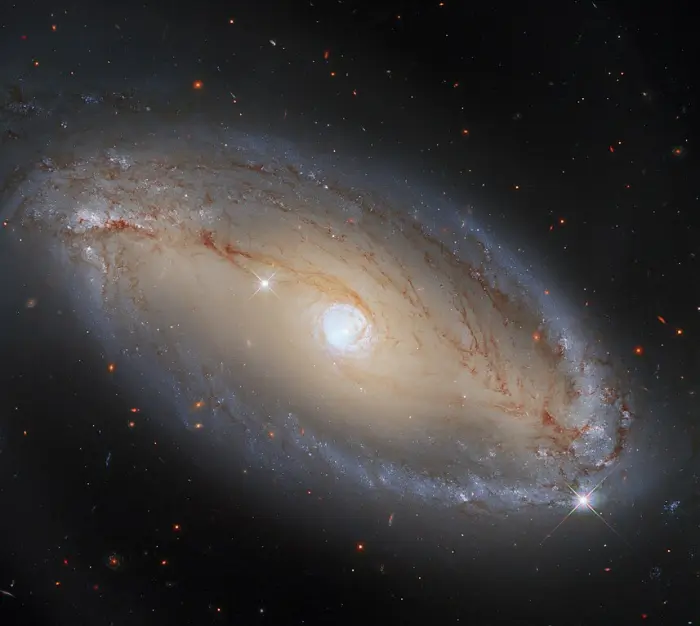
Meet NGC 5728, a spiral galaxy around 130 million light-years from Earth. This image was captured using Hubble’s Wide Field Camera 3 (WFC3), which is extremely sensitive to visible and infrared light. Therefore, this image beautifully captures the regions of NGC 5728 that are emitting visible and infrared light. However, there are many other types of light that galaxies such as NGC 5728 can emit, which WFC3 cannot see. Image credit: ESA/Hubble, A. Riess et al., J. Greene (CC BY 4.0)
NGC 5917
NGC 5917 is a spiral galaxy located approximately 90.4 million light-years away. It has an apparent magnitude of 14.5 and an apparent size of 1.6 by 0.9 arcminutes.
The galaxy is interacting with the neighbouring galaxy PGC 54817, which appears 4.2 arcminutes away. The galaxies are connected by tidal tails.
A type II supernova was discovered in NGC 5917 in June 1990. Designated SN 1990Q, it peaked at magnitude 18.
NGC 5917 was discovered by the English astronomer John Herschel on July 16, 1835.
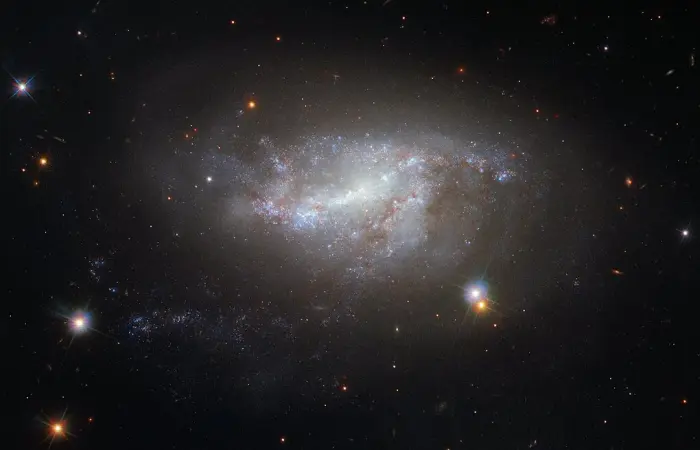
This image from Hubble’s Wide Field Camera 3 (WFC3) shows a spiral galaxy NGC 5917, perhaps best known for its intriguing interactions with its neighbouring galaxy MCG-01-39-003 (not visible here, but located off the bottom right of the frame), image credit: ESA/Hubble & NASA (CC BY 2.0)
NGC 5890
NGC 5890 is an unbarred lenticular galaxy in Libra. It was discovered by the American astronomer Ormond Stone in April 1785. It has an apparent magnitude of 14.
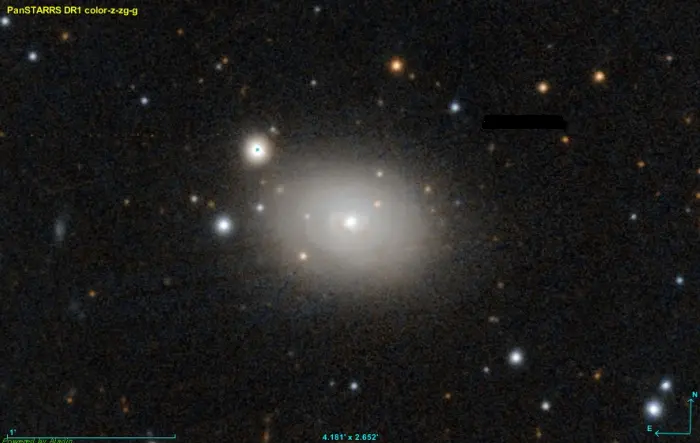
NGC 5890, image created using the Aladin Sky Atlas software from the Strasbourg Astronomical Data Center and Pan-STARRS (Panoramic Survey Telescope And Rapid Response System) public data., credit: Donald Pelletier (CC BY-SA 4.0)
IRAS 14348-1447
IRAS 14348-1447 is a pair of merging galaxies located approximately 1 billion light-years away. The colliding pair is also catalogued as PGC 52270. It has an apparent magnitude of 16.58. The interaction between the galaxies has caused the formation of tidal tails of stars pulled from the galaxies.
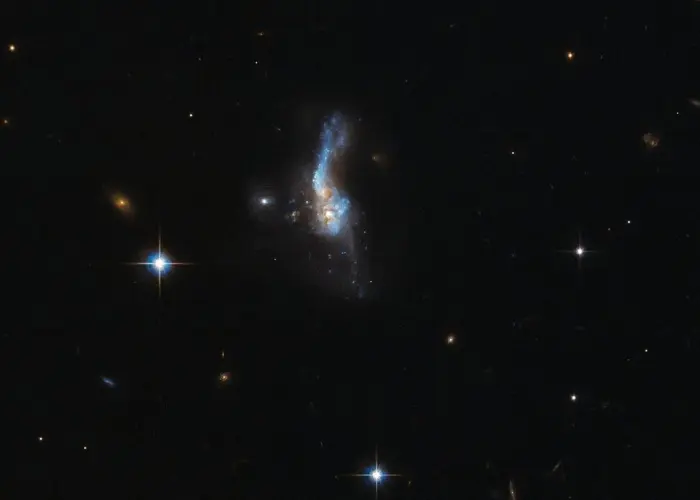
This delicate smudge in deep space is far more turbulent than it first appears. Known as IRAS 14348-1447 — a name derived in part from that of its discoverer, the Infrared Astronomical Satellite (IRAS for short) — this celestial object is actually a combination of two gas-rich spiral galaxies. This doomed duo approached one another too closely in the past, gravity causing them to affect and tug at each other and slowly, destructively, merge into one. The image was taken by Hubble’s Advanced Camera for Surveys (ACS). IRAS 14348-1447 is located over a billion light-years away from us. It is one of the most gas-rich examples known of an ultraluminous infrared galaxy, a class of cosmic objects that shine characteristically — and incredibly — brightly in the infrared part of the spectrum. Almost 95% of the energy emitted by IRAS 14348-1447 is in the far-infrared! The huge amount of molecular gas within IRAS 14348-1447 fuels its emission, and undergoes a number of dynamical processes as it interacts and moves around; these very same mechanisms are responsible for IRAS 14348-1447’s own whirling and ethereal appearance, creating prominent tails and wisps extending away from the main body of the galaxy. Image credit: ESA/Hubble & NASA (CC BY 4.0)